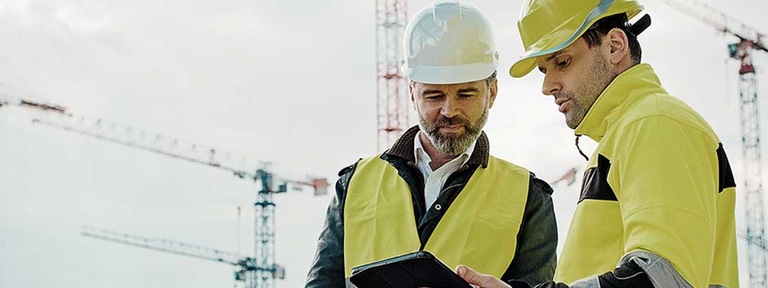
The pandemic led to a boom in the construction industry. This rapid growth brings its fair share of issues, but technology exists to help remedy the situation.
Facts
57,719 construction sites in Quebec from October 2020 to September 2021, which is 29% more than during the previous two years.1
13,000 workers lacked on construction sites in 2020.2
There’s a lot of construction going on in Québec. From October 2020 to September 2021, there were 57,719 construction sites in the province, which is 29% more than during the previous two years, according to the Association des professionnels de la construction et de l’habitation du Québec (APCHQ).
This level of growth would be hard to manage even in normal times, but the pandemic has aggravated the situation even further. In addition to having to contend with elevated demand, entrepreneurs are facing a major labour shortage, a lack of primary materials, and even issues with on-site equipment theft.
Technologies that some entrepreneurs may have once considered to be long-term investments have now become necessities needed to cope with current challenges.
Managing high demand
Is your order book overflowing? You might see this as a great problem to have. But for entrepreneurs that struggle to meet expectations and requests from clients, this situation poses a dilemma.
A number of technologies can help the construction industry to become more efficient, starting with the digitization of data. “There’s still a lot of stuff that’s written down by hand on construction sites and during visits with clients,” explains Bruno Crispin, Product and Strategy Director of Mobility Solutions and Business IoT at Videotron Business. But paper notes take time to write down, not to mention being hard to systematize, easy to lose, and even harder to trace.
Adopting digital tablets and mobile forms enables you to easily dispense with pointless, cumbersome paper notes. In addition to streamlining administrative work, a tablet on the worksite will enable conformity with architectural plans, for example, and offer entrepreneurs visiting clients the possibility of submitting their tenders before they’ve even left the premises.
Digitization also provides advantages over the competition. Visiting clients will not only be in a more professional guise, but it will allow you to acquire future clients before they have time to visit someone else while they’re waiting for your tender.
This type of digitization will also help you derive more benefit from the information you have on hand (like easily locating any problems detected in the vicinity during previous visits). “If you notice a trend where in the surrounding neighbourhood all the homes were built in the 1970s, you can then target homes in the vicinity to offer your services,” notes Crispin.
Digitization is also the first step towards adopting advanced solutions for creating a modern smart worksite.
Materials shortage and long wait times
When you regularly lack materials, automatically managing your supplies and properly planning acquisitions is essential for reducing the damaging effects of shortages.
Once a company has been digitized, resource management software (called enterprise resource planning or ERP software) enables you to ensure optimal materials and equipment turnover in your warehouse.
“If you plan well, you can know what you’ll need tomorrow or next week, but also what you currently have in stock. This allows you to order materials more intelligently,” explains Crispin.
It’s even possible to push the idea further by adopting construction industry-specific solutions offered by the Internet of Things (the term given to devices and equipment that can connect to the Internet, also known by the acronym IoT). A system of RFID tags and technology based on cellphone communications, Wi-Fi, or LoRaWAN can allow you to automatically track warehouse supplies intelligently, in addition to tracking what supplies are leaving the warehouse and being delivered to worksites.
“We can track items using weight sensors, or even with identification tags that cost practically nothing and can be attached to materials,” adds Crispin. Depending on the material or package in question, the tag can be attached with screws or adhesive or even soldered on.
Once tracking is ensured, a company can then implement automatic stock management, where certain materials can be automatically ordered before you run short of them, without human intervention. Given the current labour shortage, time gained through such technology can make all the difference.
To set up a connected warehouse, you obviously need a fast, reliable Internet connection, such as the hybrid fibre connection offered by Videotron Business. You can also get an LTE router so that traffic can automatically be redirected through a mobile network in case your Internet connection goes down, which ensures you stay connected at all times.
The warehouse also needs to have adequate Wi-Fi coverage in every corner of the building. It’s possible to request an evaluation by a technician who can come and evaluate all of your needs, then return later with adapted equipment to configure Wi-Fi Pro—an easy-to-deploy solution available at a fixed monthly rate that notably includes automatic updates, 24/7 technical support, and many cloud-based functionalities. You can also benefit from increased security with a separate Wi-Fi network for guests, employees, and devices.
Increased theft of heavy equipment
Theft of heavy equipment costs Québec entrepreneurs a lot. It not only leads to serious financial losses, but also harms companies that suddenly find themselves lacking essential equipment to fulfill work orders.
Yet fairly simple technologies exist to protect yourself, particularly geofencing, a technique involving the creation of a virtual fence around your worksite so that you receive an alert the moment a valuable piece of equipment leaves the site. Entrepreneurs can receive notifications directly on their phones, or even get a call.
Trackers can also be used to ensure better construction equipment management. They make it possible to know where everything is located in real time, which is particularly useful when companies are managing several worksites at once.
Note that geofencing also has other advantages, such as personnel tracking. The moment an employee leaves the worksite, his time at work can be logged, for example.
Geofencing isn’t the only technology for tracking equipment, materials, and tools. Connected surveillance cameras can also be installed. “Both technologies are complementary, depending on the type of worksite and the items to be tracked,” says Crispin.
Cameras generally require a bit more monitoring (to observe detected movements, for example), but there are a variety of technological tools that can make the task easier. Artificial intelligence solutions, for example, are able to differentiate between a dog and a human being captured on video, and will send an alert when a person is detected.
Connected padlocks can also be used at worksites and placed on equipment you want protected. These padlocks are easily unlocked during the day, but at night they can send an alert whenever they are used or moved, before the equipment has even had a chance to leave the confines of the site, providing personnel with even more time to react.
Through their network of reliable, established partners, many of whom are based in Québec, the experts at Videotron Business can help you target your needs and set up a variety of solutions to protect your worksites. Just set up an appointment to take advantage of their knowledge.
The labour shortage
Like many other industries, for several years the construction sector has suffered from a labour shortage which was further aggravated by the pandemic. Last year, the Commission de la construction du Québec (CCQ) estimated the industry lacked as many as 13,000 workers. From bricklaying to plumbing, every field is looking to hire. Personnel levels often approach the bare minimum needed. Companies looking to remedy the situation often therefore need to figure out how to do more with what they already have.
Many technological solutions are available. By adopting cloud-based communications, a company can, for example, make sure they’re able to reach their employees quickly at any time, whether they’re in the office, at home, or at a site.
“When clients call the company, the procedure is the same: They call, then dial the extension number. But instead of connecting to a landline, an employee can receive the call on their cellphone,” explains Crispin.
This technology also has other advantages.
In the context of the labour shortage, considerations of this type can also help you retain employees. Amongst other technology that can be deployed to keep the personnel you already have, note that it’s possible to equip employees who have to work in dangerous conditions with devices so that they can quickly make a call if they encounter problems. “An emergency button for an isolated worker will make it clear that the employer is supportive and has their welfare in mind,” explains Crispin.
Other technologies can help employees make the most of their time spent on site. Such is the case, for example, with remote truck tracking, which enables you to track the movements of your fleet. “If I know that a load of roofing tiles won’t be arriving for another 50 minutes, I can occupy my workers with something else,” illustrates Crispin.
Throughout the production chain, from ordering materials to warehouse management and organizing work on-site, technology can help Québec entrepreneurs deal with the repercussions of the pandemic and overcome the challenges particular to their industry.
4 points to remember
- Data digitization gives businesses a leg up over the competition.
- Wisely managing your inventory and planning your acquisitions with the latest technology is essential when it comes to minimizing the impacts of a shortage.
- Geofencing is an excellent option when it comes to monitoring your equipment, material, and tools.
- Several technologies can help employees maximize their time on work sites.
15 november 2021 , By Videotron Business






